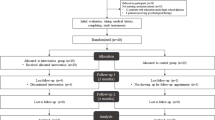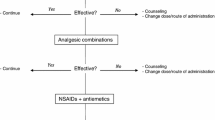Abstract
The effectiveness of two primarily self-administered treatments for chronic tension headache were compared. Twenty-four recurrent tension headache sufferers received either relaxation therapy alone or relaxation training plus cognitive-behavioral therapy in a primarily self-administered treatment format. Both treatments yielded substantial reductions in headache activity and smaller but significant reductions in depression. However, patients who received the combined treatment recorded significantly larger reductions in headache activity than patients receiving relaxation training alone. In addition, high pretreatment levels of headache activity and daily life stress were associated with a poor response to relaxation training but were unrelated to patients' response to the combined treatment. These results suggest that cognitive-behavioral interventions may enhance the effectiveness of primarily self-administered relaxation training, particularly with selected subgroups of patients.
Similar content being viewed by others
References
Andrasik, F., & Holroyd, K. A. (1980). A test of specific and nonspecific effects in the biofeedback treatment of tension headache.Journal of Consulting and Clinical Psychology, 48 575–586.
Bakal, D. A. (1982).The psychobiology of chronic headache. New York: Springer.
Bakal, D. A., Demjen, S., & Kagonov, J. A. (1981). Cognitive behavioral treatment of chronic headache.Headache, 21 81–86.
Beck, A. T., Ward, C. H., Mendelson, M., Mock, J., & Erbaugh, J. (1961). An inventory for measuring depression.Archives of General Psychiatry. 5, 561–571.
Blanchard, E. B., & Andrasik, F. (1985).Management of chronic headaches: A psychological approach. New York: Pergamon Press.
Blanchard, E. B., Andrasik, F., Ahles, T. A., Teders, S. J., & O'Keefe, D. (1980). Migraine and tension headache: A meta-analytic review.Behavior Therapy, 16 308–327.
Blanchard, E. B., Andrasik, F., Evans, D. D., Neff, D. F., Appelbaum, K. A., Rodichok, L. D., & Barron, K. D. (1985). The efficacy and cost-effectiveness of minimal-therapistcontact, non-drug treatments of chronic migraine and tension headache.Headache, 25 214–220.
Blanchard, E. B., Andrasik, F., Neff, D. F., Arena, J. G., Ahles, T. A., Jurish, S. E., Palmeyer, T. P., Saunders, N. L., Teders, S. J., Barron, K. D., & Rodichok, L. D. (1982). Biofeedback and relaxation training with three kinds of headache: Treatment effects and their prediction.Jounal of Consulting and Clinical Psychology, 50 562–575.
Budzynski, T. H., Stoyva, J. M., Adler, C. S., & Mullaney, D. J. (1973). EMG biofeedback and tension headache: A controlled outcome study.Psychosomatic Medicine, 6 509–514.
Delongis, A. M., Coyne, J. C., Dakof, G., Folkman, S., & Lazarus, R. S. (1982). Relationship of daily hassles, uplifts, and major life events to health status.Health Psychology, 1 119–136.
Holroyd, K. A. (1986). Recurrent headache. In K. A. Holroyd & T. L. Creer (Eds.)Self management of chronic disease: Handbook of clinical interventions and research (pp. 373–413). Orlando, FL: Academic Press.
Holroyd, K. A., & Andrasik, F. (1978). Coping and the self-control of chronic tension headache.Journal of Consulting and Clinical Psychology, 48 1036–1045.
Holroyd, K. A., & Andrasik, F. (1982a). A cognitive-behavioral approach to recurrent tension and migraine headache. In P. C. Kendall (Ed.),Advances in cognitive-behavioral research and therapy (Vol. 1, pp. 275–320). New York: Academic Press.
Holroyd, K. A., & Andrasik, F. (1982b). Do the effects of cognitive therapy endure? A two-year follow-up of tension headache sufferers treated with cognitive therapy or biofeedback.Cognitive Therapy and Research, 6 325–333.
Holroyd, K. A., Andrasik, F., & Westbrook, T. (1977). Cogniotive control of tension headache.Cognitive Therapy and Research. 1 121–133.
Holroyd, K. A., Appel, M. A., & Andrasik, F. (1982). A cognitive-behavioral approach to psychophysiological disorders. In D. H. Meichenbaum & M. E. Jaremko (Eds.),Stress prevention and management: A cognitive-behavioral approach (pp. 219–259). New York: Plenum.
Holroyd, K. A., Holm, J. E., Hursey, K. G., Penzien, D. B., Cordingley, G. E., Theofanous, A. G., Richardson, S. C., & Tobin, D. L. (1988). Treatment of recurrent vascular headache: A comparison of a home-based behavioral treatment with an abortive pharmacological intervention,Journal of Consulting and Clinical Psychology.
Holroyd, K. A., & Penzien, D. B. (1986). Client variables and the behavioral treatment of recurrent tension headache: A meta-analytic review.Journal of Behavioral Medicine, 9 515–536.
Infantino-Murphy, A., Lehrer, P. M., & Jurish, S. (1986).Cognitive coping skills training and progressive relaxation as treatments for tension headache. Presented at the Society for Behavioral Medicine, San Francisco.
Jacob, R. G., Turner, S. N., Szekely, B. C., & Eidelman, B. H. (1983). Predicting outcome of relaxation therapy in headaches: The role of “depression.”Behavior Therapy, 14 457–465.
Jurish, S. E., Blanchard, E. B., Andrasik, F., Teders, S. J., Neff, D. F., & Arena, J. G. (1983). Home- versus clinic-based treatment of vascular headache.Journal of Consulting and Clinical Psychology, 51 743–751.
Kraemer, H. C. (1981). Coping strategies in psychiatric clinical research.Journal of Consulting and Clinical Psychology, 49 309–319.
Steger, J. C., & Harper, R. G. (1980). Comprehensive biofeedback versus self-monitored relaxation in the treatment of tension headache.Headache, 20 137–142.
Teders, S. J., Blanchard, E. B., Andrasik, F., Jurish, S. E., Neff, D., & Arena, J. G. (1984). Relaxation training for tension headache: Comparative efficacy and cost-effectiveness of a minimal therapist contact versus a therapist delivered procedure.Behavior Therapy, 15 59–70.
Turk, D. C., Meichenbaum, D., & Genest, M. (1983).Pain and behavioral medicine: A cognitivebehavioral perspective. New York: Guilford Press.
Werder, D. S., Sargent, J. D., & Coyne, L. (1981). MMPI profiles of headache patients using self-regulation to control headache activity.Headache, 21 164–169.
Author information
Authors and Affiliations
Rights and permissions
About this article
Cite this article
Tobin, D.L., Holroyd, K.A., Baker, A. et al. Development and clinical trial of a minimal contact, cognitive-behavioral treatment for tension headache. Cogn Ther Res 12, 325–339 (1988). https://doi.org/10.1007/BF01173301
Issue Date:
DOI: https://doi.org/10.1007/BF01173301




